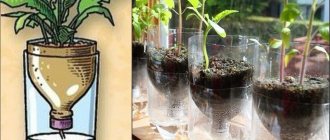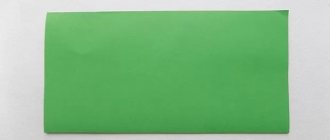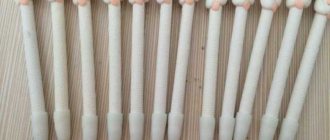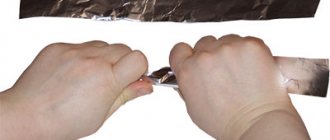Home » Building a house » Do it yourself
Alexander Korovaev 03/18/2020
747 Views
A hot tray is an important attribute of kitchen utensils. Its main purpose is to prevent damage to the surfaces of kitchen furniture when placing freshly prepared dishes on it, the containers with which are at high temperature.
Hot stand: advantages
Coasters are needed to place hot dishes on them without fear of damaging the table surface. They are special islands for eating or drinking tea, dividing the table into zones.
The design of the stands can be very different, made in the style of the kitchen or serving as a bright contrast in the overall interior.
In the photo of a homemade hot stand you can see an example of what a proper stand should be like.
This element is used for the following purposes:
- As a table decoration
- To protect the surface of the table top
Modern coasters are most often made of wood or textiles, and making them yourself is not at all difficult.
Tips for choosing
There are no small details in the kitchen, and hot pads must be chosen as carefully as possible. In order not to get confused in the wide range and choose a high-quality and attractive piece of kitchen interior, you need to take into account the properties (pros and cons) of a particular material.
Thus, wood is environmentally friendly, does not melt under the influence of high temperatures and is inexpensive, and silicone does not absorb fats and odors and does not lose its appearance during long-term use, although it is afraid of fire and damage. And the stands, made of glass ceramics and heat-resistant plastic, can also serve as cutting boards.
Wooden and cork coasters are the most popular among our housewives, but despite their environmental friendliness, they quickly get dirty and bacteria begin to develop on them from dirt and grease.
Main types
The base of the stand can be made of any material, most often it is wood, cork, cardboard, rubber, etc. It can have any shape, and hot pads are divided into types:
- Stands for cups and glassware;
- Plate stands;
- For frying pans and pots;
- For Dummies;
A stand made at home will be unique and inimitable. It will help refresh the interior and bring a little warmth to your kitchen.
Kinds
The variety of materials from which hot coasters are made sometimes confuses people. By understanding the advantages and disadvantages of the most common options, you will be able to make the right choice.
Wooden
Most often, housewives prefer wooden hot stands, for the manufacture of which they use saw cuts of various species: apple, cherry, beech, pine, juniper. Products can be made from one large round piece or several small ones. Sometimes a design is burned onto the surface. Some roughness and natural “ornament” of the stands give the interior individuality. Wooden products look good in a kitchen designed in Provence and country styles.
Consumers are attracted by the low cost of such stands, their pleasant natural aroma, and long service life. However, wood also has its drawbacks: over time, it cracks, darkens, and begins to absorb unpleasant odors.
Cork
Cork coasters for hot dishes look original. Eco-friendly base and soft natural colors harmonize effectively with a classic-style kitchen. As a standard, the products are made of inexpensive materials; they do not slip on the countertop or under hot dishes. The downside of cork coasters is their fragility; when washed, the product can crumble. In this case, it is better to purchase an accessory with a special plate that will serve as the base.
Silicone
Silicone coasters are lightweight, anti-slip, do not damage the table surface, are easy to clean, and can withstand temperatures up to 280 degrees. A wide range of colors will allow you to choose an option for any interior. Silicone will look most appropriate in a kitchen designed in a modern style.
Silicone products are easily cut and scratched, so they should be washed separately from metal utensils. It is prohibited to use such stands near an open flame - there is a high risk of ignition.
Ceramic
Ceramic coasters for hot dishes will add sophistication to the classic kitchen interior. They look impressive, expensive, easy to maintain, and are easy to clean. Such products are quite heavy, but at the same time they are fragile, requiring caution during operation - these are the main disadvantages of ceramics.
Textile
Many housewives will appreciate textile hot mats. The products are extremely practical, but at the same time they look cozy and homely. There are fabric, knitted, felted, felt. They are distinguished by anti-slip properties, will reliably protect the surface from thermal effects, and will never damage it. Among the disadvantages are that they get dirty easily, require regular washing, as a result of which they wear out quickly.
Metal
For their manufacture, stainless steel or chrome-plated metal is used. They are usually made in the form of a mesh round or square stand on legs. These elements can be made of wood, which minimizes the risk of slipping. Metal products are durable, but they are difficult to clean, especially small components. Before using this model, you need to make sure that the legs do not scratch the surface of the tabletop.
Wooden coasters
A wooden hot stand is very popular; it has many advantages and is easy to make.
It dries quickly, withstands high temperatures well and does not suffer from water. The following materials can be used:
- Basics from branches cut.
- Thin branches.
- Standard wood blanks.
The easiest way to make a stand out of wood is to use saw cuts that are glued to thick fabric. To make a tree into a shape, a chisel and a jigsaw are used; a design stencil is selected in advance, which is applied to the tree and cut out with a jigsaw.
To ensure that the product lasts as long as possible, it is varnished.
Different materials and features of their processing
Focusing on the chosen idea, which ideally combines with the interior design and other accessories, you can choose materials processing technology. To secure individual elements, you can only use a base; it can be round or square, oval or triangular.
A hot stand made of plywood is made using special equipment and tools that allow you to give the product the desired shape. To process wood materials, grinding and sawing technology is used, and the finished product can be coated with colorless varnish.
Wine cork coasters
Wine bottle corks are ideal for making coasters of different designs that can withstand temperature changes well. In this case, you can follow certain tips and use a simple algorithm for making stands for plates and hot cups:
- for work you need to select plugs of the same length and thickness;
- The plugs can be laid in a simple pattern or alternating in a checkerboard pattern;
- Having created a preliminary diagram according to its dimensions, a base is cut out of cardboard;
- for decoration, one side of the base is covered with fabric;
- the size of the fabric should exceed the base with an allowance of 1-2 centimeters;
- the fabric is glued around the perimeter, and the free edges are neatly folded;
- The corks are glued to the side not covered with textiles using a glue gun.
By combining different designs, you can make decorative stands or a whole set, which will contain models for cups, plates and even kitchen utensils. If the required material is not enough, the plugs can be cut lengthwise or crosswise, increasing the number of working elements.
From board game parts
You can make hot coasters with your own hands from board games with wooden elements that are no longer used in leisure activities. These are parts of the game of Scrabble or Majenga, from which cubes and slats are often lost, and the remaining parts have to be thrown away without finding a useful use for them.
The stands are made in a similar way; you immediately need to prepare the base on which the decorative parts of the game are glued. You can replace cubes and rectangles made of wood with ice cream sticks, large beads made of wood of the same size, and you can use simple or colored pencils.
Bright and colorful felt
A hand-sewn felt hot stand can have any design, using appliqué or patchwork techniques. Multilayer crafts perfectly protect the table surface, and a plate or cup retains heat for a long time, preventing the dish or drink from cooling quickly.
Rolling paper tubes
Paper is rarely used for practical crafts because of its fragility and rapid abrasion, which cannot be said about twisted tubes. They are pre-prepared in the required quantity and it is best to use thick sheets of glossy magazines or full-color catalogs of different companies or stores.
Long tubes are twisted in a spiral and leveled from the center, using a glue gun for point fastening in several places.
Wood cut and its design
When cleaning up the garden, cut branches of sufficiently large diameter can be used for home crafts. Saw cuts of 1.5-2 cm are carefully cleaned and freed from bark, treated with antifungal mixtures and special impregnations, and varnished to preserve the natural pattern on the wood.
Master class: wooden stand
Any detailed diagram of a hot stand will be an excellent assistant in your work. To make a wooden stand, it is best to use hardwood.
- It is necessary to prepare cuts of branches three to six centimeters thick.
- The front side of the stand is sanded with sandpaper.
- Using glue, the cut parts are glued together on a base made of plywood or thick fabric.
- The stand needs to be put under pressure and wait until it is completely dry. This may take about 6-8 hours.
You can take a wooden block and cut out identical squares from it. After this, the pieces of wood are fastened together with glue or dowels.
To prevent the stand from deforming, it must be varnished.
Manufacturing stages
Even children can be involved in the process of creating a hot stand made of wood with your own hands, since it does not require any special skills and can keep the restless for some time. And how much joy you will see in their eyes when they can give such a souvenir to their mother or grandmother. You can burn the drawings together on the saw cuts in advance.
So, the logs are ready, the tools are waiting for their turn, let's begin:
- We divide the branch into cuts 5-6 mm thick using a saw or hacksaw. Whether or not to peel the pieces from the bark is a matter of taste, but with the bark they look more harmonious and more natural;
- Using sandpaper, sand one of the sides of the resulting pieces (the one that will be the top);
- Place them face down and combine them in the order that seems most attractive to you. Make sure that each piece is adjacent to its neighbor in several places;
- We glue them together, and also lay out several circles on top and glue them to the lower parts;
- If you decide to use matting as decoration, then glue the cut circles onto the fabric on both sides;
- Now you need to dry the product, leaving it under pressure for 3-5 hours.
You can leave the saw cut in its natural form, or you can treat it with linseed oil. Such a stand for hot items made from sawn wood will last longer, and the color of the wood will acquire a golden hue.
Knitted coasters
One of the most interesting ways is a crochet stand, which is made using knitting. It is best to use acrylic yarn, it is more wear-resistant and will last a long time. There are many knitting workshops that have varying levels of difficulty.
In order to make such a stand, you need to find a suitable diagram and act strictly according to it. You can choose any colors of thread; multi-colored yarn looks very interesting and will please the eye.
Stand made of discs and fabric
CDs fit perfectly in diameter with mug stands. Therefore, using them, a huge variety of ways have been invented to create stands for high-temperature cookware.
One of these methods is to cover and cover the disc with fabric. To improve the thermal insulation characteristics, it is important to use padding made of padding polyester.
The fabric is cut with a small margin, folded over the edge of the disk, stitched at the same distance and pulled together with thread on the other side.
Fabric stand
First you need to prepare the following tools:
- Scissors;
- Pins;
- Needle and thread;
- Textile;
Stages of work:
- Sewing is best done on a sewing machine. The fabric should measure 30 by 30 cm.
- First of all, a pattern is made and transferred to the seal.
- The fabric for the stand should be folded in half, right side inward.
- A sealant is placed inside, there should be a space of 0.5 cm on the side for seams.
- It is best to stitch the seams, this way they will look much neater.
A stand in a patchwork style looks very interesting when different scraps of fabric are used for sewing.
Bottle caps
To make a stand you will need: fishing line or wire, an awl, a needle and covers. The parts are connected through holes made with an awl in the side walls of the covers.
Colored plastic lids make bright, lightweight items that are easy to care for. To ensure that the lids are firmly attached to each other, you need to repeat each stitch several times. The knots are sealed with a lighter - they will not stick out and will not come undone.
Quiz: Do You Have a Spirit Animal?
Mosaic stand
Natural materials also look great as a stand. For this purpose, sea pebbles, shells and pieces of multi-colored or plain ceramic tiles are used.
Rubber or thick fabric is used as the base. Before gluing, mosaic pieces must be degreased with alcohol. The binding material can be glue, epoxy resin or plaster.
You can use a silicone mold, which is filled with epoxy resin, and mosaic elements are laid out inside.
Stand made of pebbles and shells
You will need the following materials:
- Pebbles and shells.
- Epoxy resin.
- Any silicone mold.
Creation instructions:
- Pebbles and shells are placed in a pre-cleaned and well-dried silicone mold; they can be laid out in a pattern.
- Epoxy resin is mixed with hardener in the required volume (read the manufacturer's instructions carefully).
- The resin is carefully poured into the mold, preferably in a thin stream, so that bubbles do not form and the resin flows into all the cracks.
- After hardening (24-36 hours), carefully remove from the mold.
Original stands
- A stand made from old disks - the disk is covered with fabric, and an additional lining of synthetic padding is added inside.
- Plastic bottle caps are suitable for plates and cups, but pots and kettles that are too hot can melt and emit an unpleasant plastic smell.
- Wine bottle corks - they are glued to a base made of thick fabric and look very nice when finished. Instead of fabric and glue, the corks can be fastened together using regular toothpicks. Such stands easily absorb grease and other contaminants, so they are not considered particularly practical.
- Laying ceramic mosaics on a solid base.
- Paper coasters in quilling style.
Preparing plywood for the stand
Plywood material is very easy to process. It can be brought into the desired appearance using several options: hand tools or electrical equipment. Before processing, it is worth considering the fact that this material has an adhesive in its structure that glues several sheets of veneer together. It has a bad effect on the properties of the cutting tool and can dull it. Therefore, you need to choose a durable type of cutting equipment for processing the plywood surface.
Cutting plywood requires durable equipment.
If you need to cut plywood, then you should use a circular saw. If you use the tape type, then it is impossible to guarantee an excellent result; a wavy cut may form. It is necessary to saw the material as follows: you should cut across the fibers and their direction on the upper side of the material, then make a cut along the fibers.
You need to cut plywood across the grain.
When drilling, to obtain an accurate and neat hole, choose a sharp drill bit equipped with a front cutter. You need to drill from the front side, which is more durable. If you want to avoid splitting, you need to place a backing under the plywood when drilling.
Other materials
Making coasters from wood and knitting coasters for hot dishes are very popular, but besides them, there are many other options for this decorative element.
- Coasters made from bamboo sticks and silicone turn out to be very beautiful; they can also be sewn from felt and made from metal.
- Tempered glass trivets are suitable for pans and pots and are incredibly strong and durable.
- Stands woven from willow or birch bark look very original.
A well-made hot stand will last a very long time and will fit perfectly into any kitchen interior.
Twigs
You can easily create an interesting stand using twigs, base and glue. The ornament is formed with thick branches, and the gaps are filled with small remains.
Both PVA glue and super glue will work. Any wood can be used, but it is worth recommending birch - birch bark does not rot and will last a long time. In this case, you can lay out the most bizarre pattern. The finished work is dried under pressure for 24 hours.
Photo of a hot stand
Stone stand
Having visited the sea, obligatory souvenirs are a variety of pebbles, shells, and pieces of glass. Craftswomen use them to create original coasters. After all, when turned by sea water, stones become smooth to the touch, without sharp chips or joints.
The basis for the decorative element can be a wooden washer, an old CD, or any other round and even object.
Decide on a pattern, placing them in the order that you think will be good. And then simply place each element on a rough (sand before starting work) base using hot glue. By the way, it is advisable to use hot glue, because PVA is not intended for stone, and rubber Moment is often opaque. If you really want, you can find a colorless one.
When finished with the adhesive, check the evenness of the resulting surface by placing an empty cup on it. If it is crooked, it is better to sand the top with sandpaper.
Sanding takes a lot of time, so it is better to choose materials of equal height.
To make the accessory even more reliable, cover it with a layer of colorless varnish.
There is a possibility that when making a stand using this method, the stones may fall off. Therefore, it is best to use plaster, silicone, cement in combination with glue. Apply a layer sufficient to cover the glass and pebbles by a third. After hardening, coat with varnish.
Stone products are usually left unpainted to highlight their natural beauty. Some still use white to color the base.
How to make from clothespins
A very original craft is obtained if ordinary wooden clothespins are used. Required materials for production:
- clothespins;
- glue;
- bank rubber bands.
No tools are required to create the product. Step-by-step manufacturing instructions consist of several points.
- The wooden parts of the clothespin come apart. A metal spring is not needed.
- Both halves are glued together on the outside and pressed with rubber bands.
- The rubber bands are removed after the glue dries.
- The clothespins are glued together to form a circle.











